Given that I have had these for almost 40 years I will probably rebuild the XO as described in the article (seeing as I was not dissatisfied with the stock configuration).
Eventually I may do the following:
1.) Zobelize the drivers to smooth the impedance curves.
2.) Design a Linkwitz-Riley filter to the "smoothed impedance".
3.) Insert an LPad between XO and Zobelized driver in cases where I need to match the efficiency of drivers.
4.) Linkwitz-Riley benefits from time-alignment - so could do that also.
That said if I am real happy with the results of my stock build I will just get lazy and leave it.
Upgrades I am making this time around are:
1.) Better quality XO wiring.
2.) Better Caps.
3.) Better resistors.
4.) Better solder (WBT silver).
5.) New front baffle with no diffraction points.
Eventually I may do the following:
1.) Zobelize the drivers to smooth the impedance curves.
2.) Design a Linkwitz-Riley filter to the "smoothed impedance".
3.) Insert an LPad between XO and Zobelized driver in cases where I need to match the efficiency of drivers.
4.) Linkwitz-Riley benefits from time-alignment - so could do that also.
That said if I am real happy with the results of my stock build I will just get lazy and leave it.
Upgrades I am making this time around are:
1.) Better quality XO wiring.
2.) Better Caps.
3.) Better resistors.
4.) Better solder (WBT silver).
5.) New front baffle with no diffraction points.
Last edited:
I knew I had a second set 🙂
Was a nice search !!
So did a second setup in the cabinets I had.
B110b (1057) in 6,7L BR.
They had Audax tweeters , so I changed for T27.
Did an intuitive SCS XO (same setup as the Krill) .
Final adjust by ear.
Last evening 3 hours listening and comparing with 2 audiophile guests.
We all agreed that the SCS XO is more engaging 🙂 and beats the KEF XO.
It's always nice to have some stock parts.
Next step for me will be :
The Bass from the first set with SCS XO 🙂
I'll keep the updates coming , if people are interested ?
sinc. Leon.
Was a nice search !!
So did a second setup in the cabinets I had.
B110b (1057) in 6,7L BR.
They had Audax tweeters , so I changed for T27.
Did an intuitive SCS XO (same setup as the Krill) .
Final adjust by ear.
Last evening 3 hours listening and comparing with 2 audiophile guests.
We all agreed that the SCS XO is more engaging 🙂 and beats the KEF XO.
It's always nice to have some stock parts.
Next step for me will be :
The Bass from the first set with SCS XO 🙂
I'll keep the updates coming , if people are interested ?
sinc. Leon.
Attachments
Leon, are you referring to the KEF XO from the article I posted? If so I don't think it was designed for the 110B.
Yes, I am interested in your updates and will post mine also.
Yes, I am interested in your updates and will post mine also.
I have CS1 XO for B110b.
Gonna try Falcon topoolgy also.
Have just found set B110 a 🙂
With 2 sets , it's nice to compare sound.
Making it a competition and keep tweaking until one is the best 🙂
Gonna try Falcon topoolgy also.
Have just found set B110 a 🙂
With 2 sets , it's nice to compare sound.
Making it a competition and keep tweaking until one is the best 🙂
Well, I have my clones rebuilt per the article I posted. And they sound Awesome.
Never remember them having as much well defined reasonably deep bass as they do now. Running them with the following combo:
Sony 999ES DVD/CD ==> Pass DIY B1 Buffer ==> Rowland Model 1.
The Rowland has a fat low end so probably that is helping.
Outstanding sound! Clear, detailed, with wide and deep sound-stage.
Currently on make shift stands about twenty one inches high while I construct new stands. Will post pics once the stands are done.
Never remember them having as much well defined reasonably deep bass as they do now. Running them with the following combo:
Sony 999ES DVD/CD ==> Pass DIY B1 Buffer ==> Rowland Model 1.
The Rowland has a fat low end so probably that is helping.
Outstanding sound! Clear, detailed, with wide and deep sound-stage.
Currently on make shift stands about twenty one inches high while I construct new stands. Will post pics once the stands are done.
Last edited:
Hi all. Here are a few pictures. These came out real nice and sound terrific (really good on my restored SX-1250 surprisingly enough). Still need to paint the stands (they are 24 inches high).
My workaround for the dividing network that was burning off low frequency power was to put an 8.2 ohm resister in series with the tweeter filter. This was done by experimentation in order to get the levels correct (I left them a little on the bright side but that will be toned down by my Rowland Model 1 as it is dark). As it turns out after that change both the low and high pass are around 15 ohms nominal.
My workaround for the dividing network that was burning off low frequency power was to put an 8.2 ohm resister in series with the tweeter filter. This was done by experimentation in order to get the levels correct (I left them a little on the bright side but that will be toned down by my Rowland Model 1 as it is dark). As it turns out after that change both the low and high pass are around 15 ohms nominal.
Attachments
Having slogged for about 4 hours reading through this entire thread, its pretty amazing the discussion and experiments and speakers that have been done with the venerable, old, and outdated (terms used here and elsewhere) KEF B110A SP1003 and T27 SP1032 drivers, plus crossovers and box designs.
I was intrigued to read the discussion on thin-wall damped and thick wall considerations and how research and experimental data collides with "intuitive" pre-conceptions. It goes a long way to describe the various methodologies that designers use in cabinet designs big and small, and the various compromises done when size, weight, cost and construction factors must be considered.
I am not without bias as I am the moderator of the Yahoo! LS3/5a newsgroup, based loosely in the UK and US. I of course am also aware of many many efforts at helping make the LS3/5a a useful and effective performer and sound reproducer "within its specific design brief and design limitations". This particular factor must be remembered and taken into consideration when evaluating the speakers, and when comparing them to anything else, small or large.
There's a considerable population of "anoraks" enamored with the LS3/5a who have tried many many things to improve how the LS3/5a works in a domestic environment to reproduce music and voice, and quite a few involve adding additional low frequency (Rogers AB1 and similar) enhancement to fill out the range below the LS3/5a's natural cutoff. Still, there is considerable praise for the generally natural midrange and vocal capability of the LS3/5a, assuming proper adjustments have been made for aging effects of the woofers (to tame resonances that have crept into these aging veterans). On our board, there have been discussion on how to assess and implement changes to the crossover to adjust for that and get the speaker back closer to nominal LS3/5a specification. The later 11 ohm version was created to address the shortcomings of the original SP1003 and its revised 1970's construction with the use of a later more modern woofer, the B110C SP1228, produced in 1987 till roughly 2004. It retained Bextrene as its cone material but different cone profile, damping scheme, and surround material, as well as improved former and coil properties.
As well known, the BBC LS3/5a specification has been met with more modern non-KEF drivers as in the Stirling V2, the Rogers 50th and 60th Anniversary models and various later variants from Spendor and Harbeth that are quite similar. I personally do not include the various LS3/5a wannabe copies from the Far East that ride on the coattails of the LS3/5a (even using the same designation without license) although I assume the engineering to be competent and the speakers to sound good. As noted in this thread, its pretty easy to build a speaker that looks like the LS3/5a, but the devil is in ALL the details that goes into the design and execution, plus the ability and skill of those who audition and tweak the design relative to listening to the real thing.
At the risk of the ire of the DIY community, it is one thing to do all the simulations and get close to the target, and quite another to fully realize a functioning physical system that sounds close to what you think you want it to sound like.
The LS3/5a was designed as a tool for use by the BBC, not only in broadcast vans, but in small studio and voice monitoring applications. By definition as an LS3 model, it was a Grade 2 monitor, sufficient for monitoring, but not for wholesale broadcast adjustments as it was not wide ranging enough frequency wise (of course) for that purpose, that was left to the LS5 range (LS5/8, LS5/9, LS5/12, all of various sizes and output ranges). As such, like many other professional monitors, its balance and timbre is tilted to revealing rather than pleasing like many consumer speaker models are. IMO, the LS3/5a is not a speaker made to impress, it is to create a window, albeit a small window, on a realistic performance or vocal. Many have pointed out the slight nasality of the bextrene cone, the "tizz" of the top end (chosen to address FM broadcast and tape hiss issue of the day), and the lack of high SPL capability (really only capable of 95-98db tops, and probably with some strain ensuing.
Yet there are so many who (perhaps romantically or with bias) gush about how great the midrange and vocal reproduction is, how well it works with generally simple, laid back, or relaxed music (acoustic guitar, vocals, small jazz) but get quite confused with large orchestra, multilayered rock, and music needing huge dynamic range (for which it wasn't designed nor capable of reproducing). Such is the life of a speaker that is designed as one thing, and pressed into service to attempt to do so much more - it has limitations, as do pretty much any speaker system, at least within typical reason and parameters chosen.
Just sharing some general thoughts, and seeing how the thread participants have done with their speaker system builds, plus maybe getting the thread going again on the LS3/5a tradeoffs (of that era). As some of our newsgroup members have stated, the LS3/5a was designed and built with specific parts, design choices and limitations, and then refined over a 1-2 year time frame, with arguments about 0.1 db theoretical and real choices, and with real time vocal comparisons and listening tests as the ultimate arbiter of voicing. Despite having a lumpy frequency response, the speaker generally sounds quite real for its day, and even perhaps today.
For the parts and design chosen, many feel it was optimized to balance on the head of a pin, so to speak, so that choosing and altering a parameter may actually degrade its performance. In a DIY forum, that is probably heresy because "anything can be improved" or rather changed, but does it get better? So yes, one can build a "better" speaker, but it will likely be bigger, heavier, maybe active, maybe larger drivers, etc. which changes all the parameters the LS3/5a was limited to or designed to.
Regards,
Bart
Moderator, Yahoo! LS3/5a newsgroup
I was intrigued to read the discussion on thin-wall damped and thick wall considerations and how research and experimental data collides with "intuitive" pre-conceptions. It goes a long way to describe the various methodologies that designers use in cabinet designs big and small, and the various compromises done when size, weight, cost and construction factors must be considered.
I am not without bias as I am the moderator of the Yahoo! LS3/5a newsgroup, based loosely in the UK and US. I of course am also aware of many many efforts at helping make the LS3/5a a useful and effective performer and sound reproducer "within its specific design brief and design limitations". This particular factor must be remembered and taken into consideration when evaluating the speakers, and when comparing them to anything else, small or large.
There's a considerable population of "anoraks" enamored with the LS3/5a who have tried many many things to improve how the LS3/5a works in a domestic environment to reproduce music and voice, and quite a few involve adding additional low frequency (Rogers AB1 and similar) enhancement to fill out the range below the LS3/5a's natural cutoff. Still, there is considerable praise for the generally natural midrange and vocal capability of the LS3/5a, assuming proper adjustments have been made for aging effects of the woofers (to tame resonances that have crept into these aging veterans). On our board, there have been discussion on how to assess and implement changes to the crossover to adjust for that and get the speaker back closer to nominal LS3/5a specification. The later 11 ohm version was created to address the shortcomings of the original SP1003 and its revised 1970's construction with the use of a later more modern woofer, the B110C SP1228, produced in 1987 till roughly 2004. It retained Bextrene as its cone material but different cone profile, damping scheme, and surround material, as well as improved former and coil properties.
As well known, the BBC LS3/5a specification has been met with more modern non-KEF drivers as in the Stirling V2, the Rogers 50th and 60th Anniversary models and various later variants from Spendor and Harbeth that are quite similar. I personally do not include the various LS3/5a wannabe copies from the Far East that ride on the coattails of the LS3/5a (even using the same designation without license) although I assume the engineering to be competent and the speakers to sound good. As noted in this thread, its pretty easy to build a speaker that looks like the LS3/5a, but the devil is in ALL the details that goes into the design and execution, plus the ability and skill of those who audition and tweak the design relative to listening to the real thing.
At the risk of the ire of the DIY community, it is one thing to do all the simulations and get close to the target, and quite another to fully realize a functioning physical system that sounds close to what you think you want it to sound like.
The LS3/5a was designed as a tool for use by the BBC, not only in broadcast vans, but in small studio and voice monitoring applications. By definition as an LS3 model, it was a Grade 2 monitor, sufficient for monitoring, but not for wholesale broadcast adjustments as it was not wide ranging enough frequency wise (of course) for that purpose, that was left to the LS5 range (LS5/8, LS5/9, LS5/12, all of various sizes and output ranges). As such, like many other professional monitors, its balance and timbre is tilted to revealing rather than pleasing like many consumer speaker models are. IMO, the LS3/5a is not a speaker made to impress, it is to create a window, albeit a small window, on a realistic performance or vocal. Many have pointed out the slight nasality of the bextrene cone, the "tizz" of the top end (chosen to address FM broadcast and tape hiss issue of the day), and the lack of high SPL capability (really only capable of 95-98db tops, and probably with some strain ensuing.
Yet there are so many who (perhaps romantically or with bias) gush about how great the midrange and vocal reproduction is, how well it works with generally simple, laid back, or relaxed music (acoustic guitar, vocals, small jazz) but get quite confused with large orchestra, multilayered rock, and music needing huge dynamic range (for which it wasn't designed nor capable of reproducing). Such is the life of a speaker that is designed as one thing, and pressed into service to attempt to do so much more - it has limitations, as do pretty much any speaker system, at least within typical reason and parameters chosen.
Just sharing some general thoughts, and seeing how the thread participants have done with their speaker system builds, plus maybe getting the thread going again on the LS3/5a tradeoffs (of that era). As some of our newsgroup members have stated, the LS3/5a was designed and built with specific parts, design choices and limitations, and then refined over a 1-2 year time frame, with arguments about 0.1 db theoretical and real choices, and with real time vocal comparisons and listening tests as the ultimate arbiter of voicing. Despite having a lumpy frequency response, the speaker generally sounds quite real for its day, and even perhaps today.
For the parts and design chosen, many feel it was optimized to balance on the head of a pin, so to speak, so that choosing and altering a parameter may actually degrade its performance. In a DIY forum, that is probably heresy because "anything can be improved" or rather changed, but does it get better? So yes, one can build a "better" speaker, but it will likely be bigger, heavier, maybe active, maybe larger drivers, etc. which changes all the parameters the LS3/5a was limited to or designed to.
Regards,
Bart
Moderator, Yahoo! LS3/5a newsgroup
Excellent contribution, Bart. You got that right.
Harbeth must have done the best upgrade to modern, IMO. The "cracked bell" front panel. The ply construction. The recessed woofer. 😎
http://www.diyaudio.com/forums/multi-way/223174-interesting-read-i-found-lossy-cabinet-designs-harbeth.html

I don't yet quite have the modelling ability to take this much further, at least until I buy the Monacor simulating software to use one of their polycones. But I always noticed the negative polarity on the tweeter. That is 18db/octave BW3 around 3.5kHz and very BBC.
It gives it good dispersion. If you did LR2 or LR4, or went lower crossover, you are creating something different IMO. Better or worse, it's a matter of taste. 😀
Harbeth must have done the best upgrade to modern, IMO. The "cracked bell" front panel. The ply construction. The recessed woofer. 😎
http://www.diyaudio.com/forums/multi-way/223174-interesting-read-i-found-lossy-cabinet-designs-harbeth.html

I don't yet quite have the modelling ability to take this much further, at least until I buy the Monacor simulating software to use one of their polycones. But I always noticed the negative polarity on the tweeter. That is 18db/octave BW3 around 3.5kHz and very BBC.
It gives it good dispersion. If you did LR2 or LR4, or went lower crossover, you are creating something different IMO. Better or worse, it's a matter of taste. 😀
As such, like many other professional monitors, its balance and timbre is tilted to revealing rather than pleasing like many consumer speaker models are. IMO, the LS3/5a is not a speaker made to impress, it is to create a window, albeit a small window, on a realistic performance or vocal. Many have pointed out the slight nasality of the bextrene cone, the "tizz" of the top end (chosen to address FM broadcast and tape hiss issue of the day), and the lack of high SPL capability (really only capable of 95-98db tops, and probably with some strain ensuing.
I would have to say that this description mirrors the sound of my clones almost exactly.
Harbeth must have done the best upgrade to modern, IMO. The "cracked bell" front panel. The ply construction. The recessed woofer. 😎
Harbeth use veneered MDF cabinets, not ply.
Their LS3/5A may have used ply to meet BBC spec, but their other models do not share that feature.
Mr. dB, I kinda cut loose on ideas. Whatever works. IDK exactly what Alan Shaw does at Harbeth on ideas. But he is in the BBC tradition of light and damped-panel cabinet construction. Here the M30.1 polycone 8" bass plus 1" metal tweeter. Good, by all accounts. Joachim Gerhard might find a better material like laminated bamboo.Harbeth use veneered MDF cabinets, not ply.
Their LS3/5A may have used ply to meet BBC spec, but their other models do not share that feature.
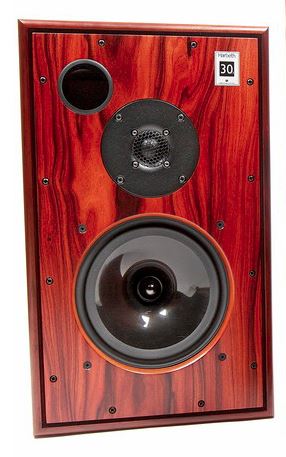
Very practical reason is that moving a heavy portable monitor is hard work for the roadies. He also uses SEAS metal dome tweeters, rather than the mylar type. Which are OK, IMO.
Nobody is ever going to build a perfect speaker, IMO. A lot of tradeoffs in a real room and on filters. But occasionally we win a cigar. 😀
How can jr149's stand up against ls3/5 and can JR149 be improved.
I am sure this must;ve been discussed here and I am aware that the JR149's have a relatively simple and cheaper x-over but uutilise the same drivers. Are there any non destructive ways to improve the 149's. Active x-over for instance.
I am sure this must;ve been discussed here and I am aware that the JR149's have a relatively simple and cheaper x-over but uutilise the same drivers. Are there any non destructive ways to improve the 149's. Active x-over for instance.
Just found this tread, was out of the building scene for 25 years. So good to see the SOTA's are still a discussion topic. Listening to them now with my favorite Salsa music of Orquesta de la Luz. (Wife is not home!!) I am with Aswin on this, they are the best.
I have recently built a speaker inspired by the LS3/5A but using readily available but high quality parts. It sounded so good as a prototype, I am having a nice set of 6 made with BB ply and oak battens (could not get beech easily). The crossover is very different at 5.5khz but the overall response is similar in shape and the step response is a very close match according to the Stereophile measurements.
RST28F and DC130A Foamcore Homage to LS3/5A
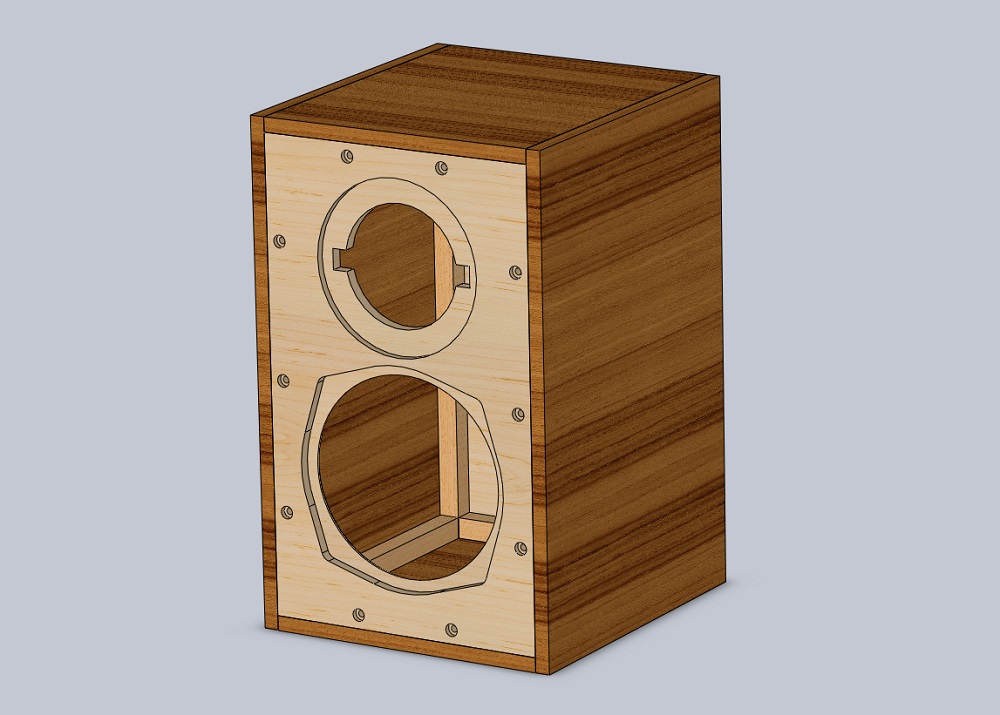
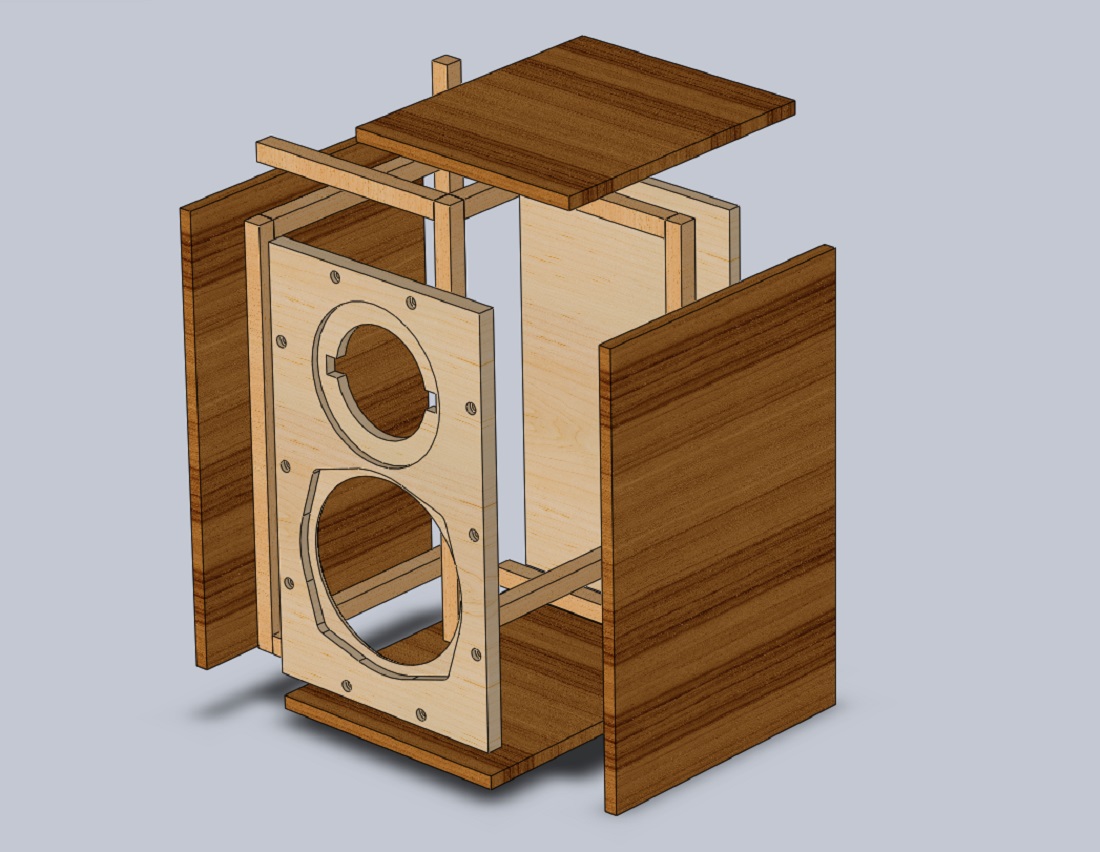
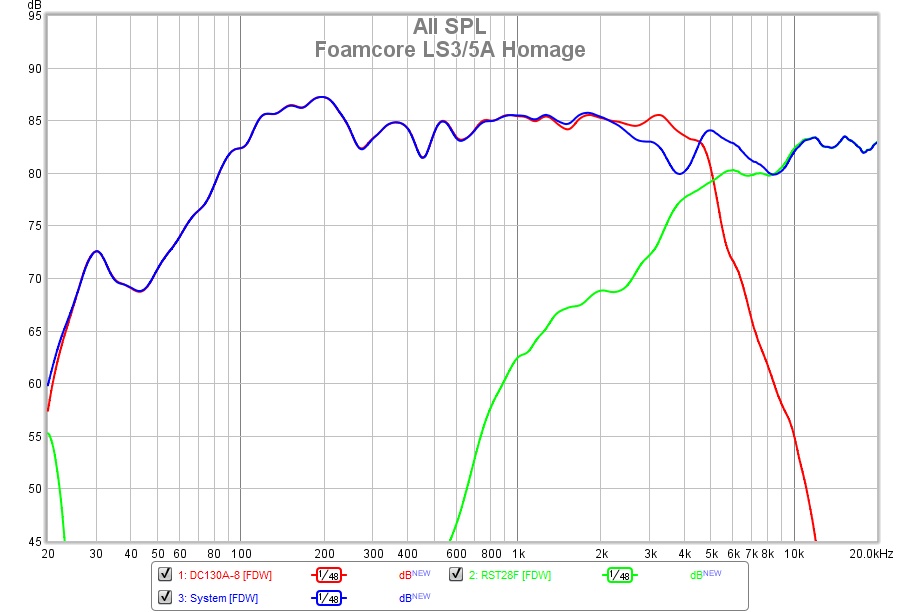
Step response:

Crossover:
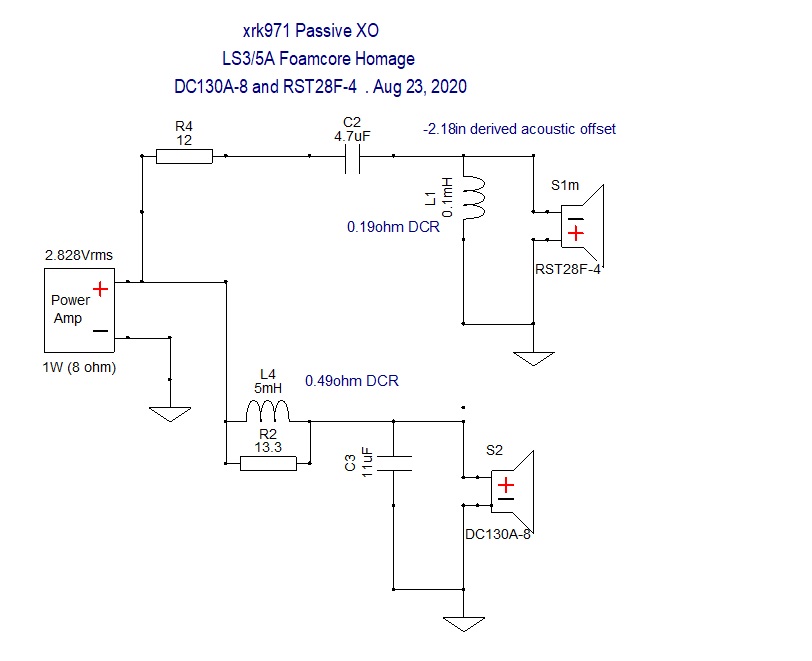
The box construction is coming along well:
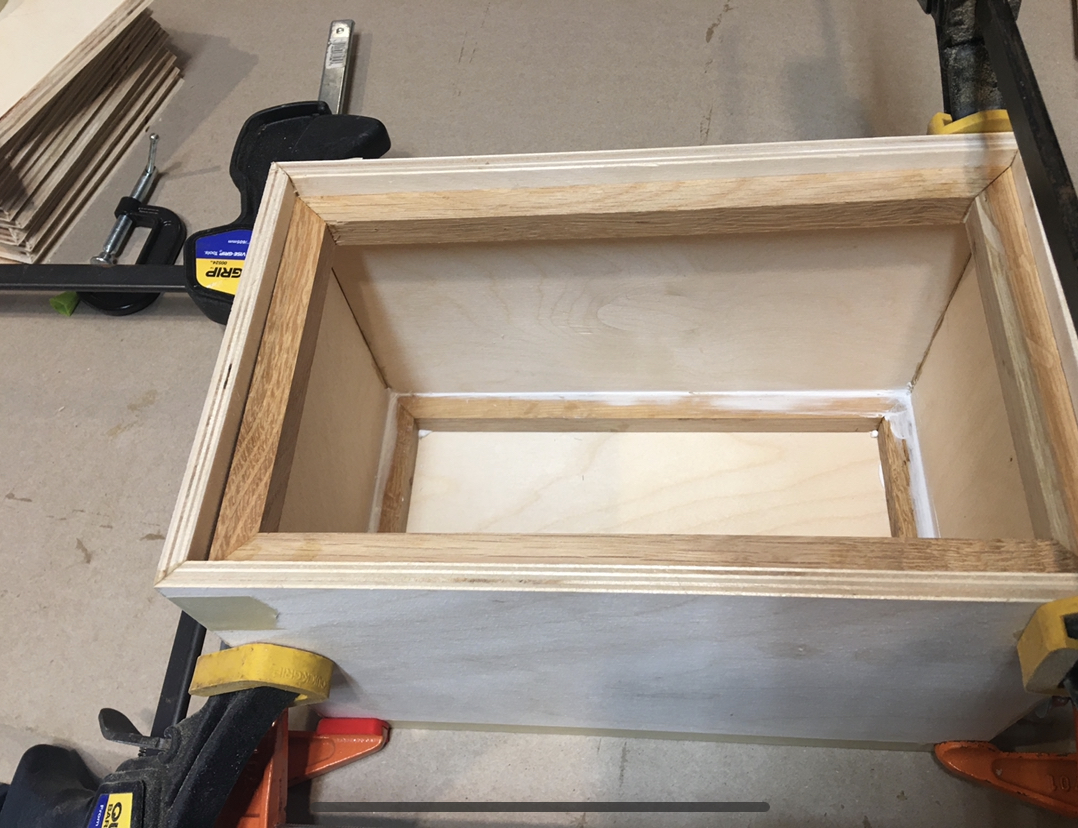
Back panels with inlaid white oak used on battens recovered from a Civil War barn near Rockville, Maryland:
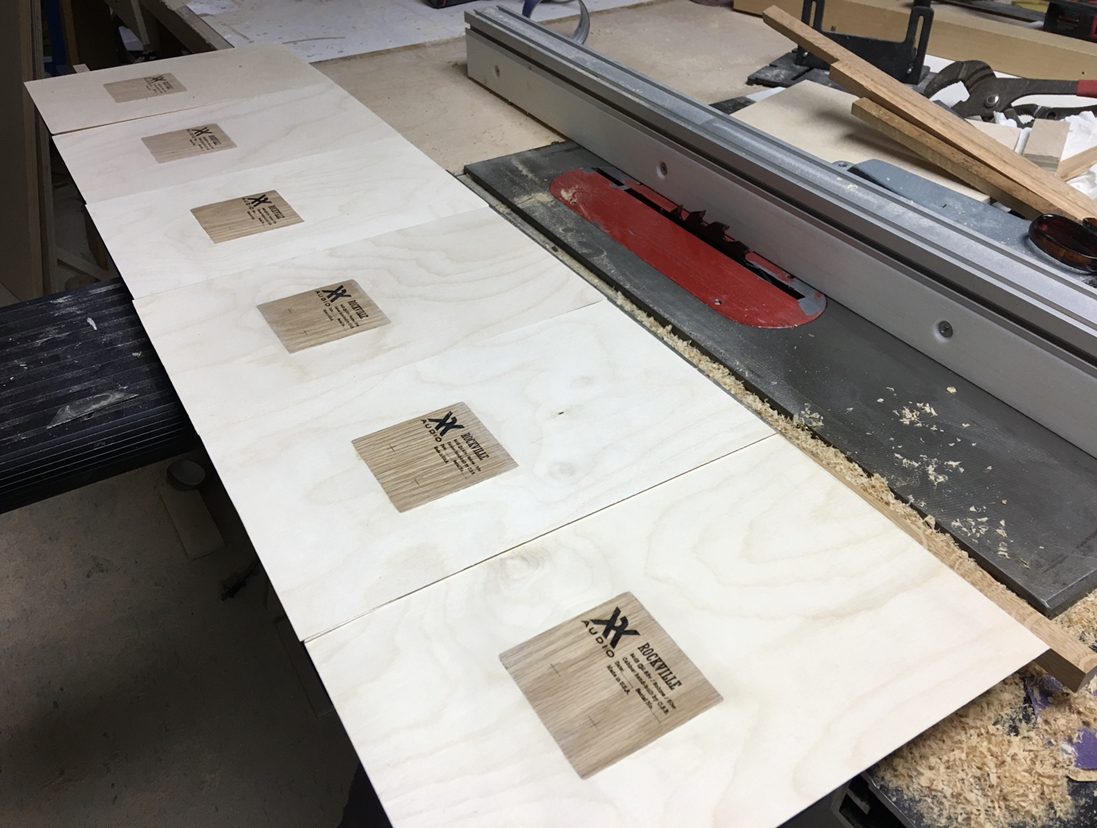
Battens are framed mitered and framed outside and glued to panels with latex caulking for CLD type damping. Corners of battens are affixed to panels with PL Premium for strength and robustness. Front is 12mm BB ply to give room for flush rebates, all other panels are 9mm, and all mitered corner construction held together with PL Premium.
The baffle cutouts will be the last step and will be done this week.
RST28F and DC130A Foamcore Homage to LS3/5A
Step response:
Crossover:
The box construction is coming along well:
Back panels with inlaid white oak used on battens recovered from a Civil War barn near Rockville, Maryland:
Battens are framed mitered and framed outside and glued to panels with latex caulking for CLD type damping. Corners of battens are affixed to panels with PL Premium for strength and robustness. Front is 12mm BB ply to give room for flush rebates, all other panels are 9mm, and all mitered corner construction held together with PL Premium.
The baffle cutouts will be the last step and will be done this week.
Last edited:
I watch with fascination, xrk971!
You are becoming quite the BBC man on cabinet construction:

TBH, it's 40 years since I heard a BBC LS3/5A. Thin plywood construction. What I can tell you is the thin hardwood beech battens are just there for cabinet strength. I possibly get annoying in my insistence that what this speaker did well was Butterworth3 90 degree phase response. But many subtleties there.
But we aren't expecting a 5" bass to shake the room with bass. Why I didn't buy it. 🙂
You are becoming quite the BBC man on cabinet construction:
TBH, it's 40 years since I heard a BBC LS3/5A. Thin plywood construction. What I can tell you is the thin hardwood beech battens are just there for cabinet strength. I possibly get annoying in my insistence that what this speaker did well was Butterworth3 90 degree phase response. But many subtleties there.
But we aren't expecting a 5" bass to shake the room with bass. Why I didn't buy it. 🙂
Well, i'm also busy with a variation of it, as the thin wall mass damped lossy cabinet (like used in the LS3/5A) seems to work very well. I did build some fullrange boxes with this principle and those were the best i build. The original drivers of the LS3/5A are indeed outdated like some of you mention here, but the general principle not. That's why i wanted since longtime to do something with it with modern drivers.
And now going to do an own 2 way with the SB26ADC and the Dayton RS180 woofer (wich is a great combo). Mine is not a clone, but a variation based on it's principle (sealed 2 way in a thin wall mass damped lossy cabinet) and i'm going to add a sub to it later but on it's own it should get a F6 of 50Hz. I'm waiting for the wood to be delivered now...
And now going to do an own 2 way with the SB26ADC and the Dayton RS180 woofer (wich is a great combo). Mine is not a clone, but a variation based on it's principle (sealed 2 way in a thin wall mass damped lossy cabinet) and i'm going to add a sub to it later but on it's own it should get a F6 of 50Hz. I'm waiting for the wood to be delivered now...
I have a recollection of having read a BBC paper stating that they had problem soundwise with a batch of LS3/5As and the reason was down to the battens being of softwood instead of hardwood.
- Home
- Loudspeakers
- Multi-Way
- Can one build a better (non) LS3/5A speaker based on T27s & B110s?







